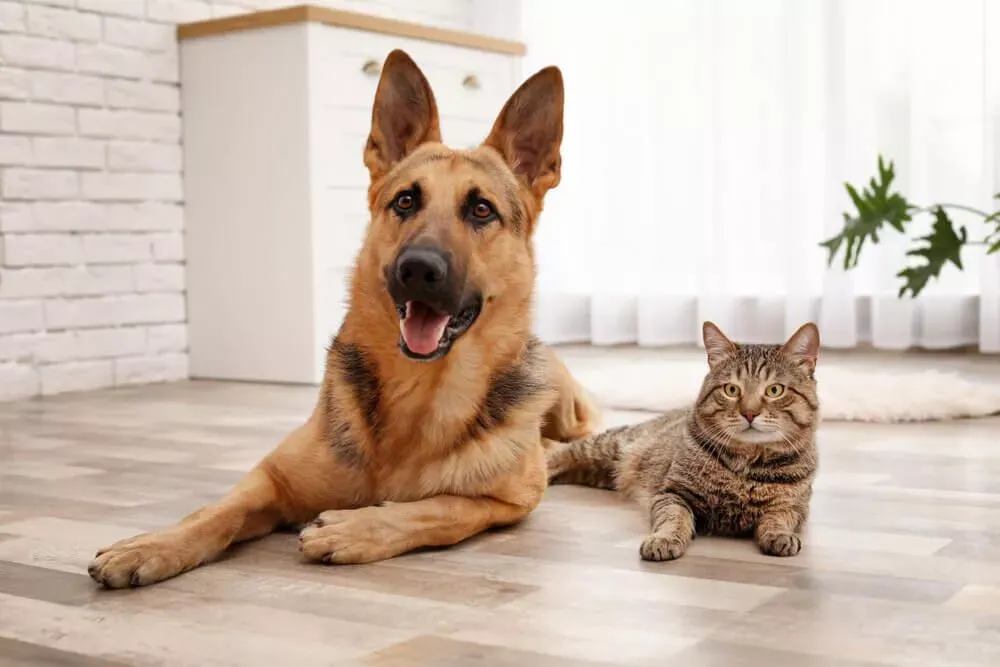Despite popular myths that dogs and cats can’t coexist, many German Shepherds form strong bonds with feline companions. However, these large, intelligent working dogs have unique traits that require careful management when living with cats. If you’re wondering about German Shepherds with cats, this guide covers their compatibility, potential risks, and proven introduction strategies. Whether you’re adopting a puppy or integrating an adult Shepherd into a cat-filled home, understanding these dynamics ensures a harmonious household.
German Shepherd Traits Around Cats
German Shepherds were bred for herding sheep and later excelled as police and military dogs, instilling a strong prey drive, protective instincts, and high energy levels. This herding background can translate to chasing or nipping at cats, treating them like livestock rather than housemates. Their intelligence and eagerness to please make them highly trainable, though—positive reinforcement techniques can redirect these instincts effectively.
 Positive reinforcement training helping a German Shepherd integrate with cats
Positive reinforcement training helping a German Shepherd integrate with cats
Veterinary behaviorists emphasize that early socialization plays a crucial role. German Shepherds thrive on structure and mental stimulation, so incorporating cat-friendly obedience training from a young age builds confidence and reduces impulsive behaviors. For instance, teaching commands like “leave it” or “focus” prevents fixation on moving cats. Experienced owners report success by channeling the breed’s work ethic into puzzle toys and agility exercises, mimicking their herding roots without targeting pets.
Will My German Shepherd Hurt My Cat?
Not every German Shepherd is inherently cat-aggressive, but individual temperament varies widely. Their powerful jaws and size mean a chase could injure or traumatize a cat—even unintentionally. Dogs with intense predatory drives may view cats as prey, making unsupervised interactions risky.
According to the American Kennel Club (AKC), breeds like German Shepherds often succeed with cats if properly trained, but a veterinary behaviorist consultation is essential for high-drive individuals. Assess your dog’s history: Rescue Shepherds from working lines might need extra evaluation. Signs of poor compatibility include stiff body language, intense staring, or lunging. Prioritize safety by starting introductions in controlled environments, using barriers if needed.
Step-by-Step Guide: Safely Introducing Your German Shepherd to Cats
Successful integration of German Shepherds with cats hinges on patience, consistency, and gradual exposure. Rushing can reinforce chasing as rewarding, so “little and often” is the mantra—short, positive sessions build tolerance over weeks or months.
Begin with scent swapping: Rub a blanket on your cat and let your Shepherd sniff it, rewarding calm reactions with treats. Provide separate safe spaces—cats need vertical perches and escape routes via cat trees or shelves, as recommended by the ASPCA for multi-pet homes. Puppies under six months adapt fastest due to their malleable brains, but adults can learn too with professional guidance.
 Slow and steady introduction between a German Shepherd puppy and household cats
Slow and steady introduction between a German Shepherd puppy and household cats
For visual meetings, leash your German Shepherd and use a pet gate or glass door. Let the cat dictate the pace—never corner them. Reward your dog for ignoring the cat: sit, lie down, or look away. Clicker training amplifies this; pair a click sound with high-value treats to mark desired behaviors instantly. If arousal spikes (barking, pulling), increase distance and retry—no scolding, as it creates fear associations.
Progress slowly: Shorten the leash, extend session times, then practice off-leash in a secure room. Always supervise until they’ve coexisted calmly for months. Common pitfalls include forcing proximity or ignoring feline stress signals like flattened ears or tail swishing. Real-world tip from breeders: Daily 15-minute sessions over 4-6 weeks often yield relaxed interactions.
More resources, like the International Association of Animal Behavior Consultants (IAABC), offer protocols tailored to herding breeds.
 German Shepherd and cat coexisting peacefully in a home environment
German Shepherd and cat coexisting peacefully in a home environment
Can My Cat Hurt My German Shepherd?
While German Shepherds pose the greater physical threat, cats aren’t defenseless. Scared felines lash out with claws, potentially scratching eyes or causing infections. Puppies are especially vulnerable—their incomplete blink reflex until 12 weeks heightens corneal ulcer risks, per veterinary ophthalmology studies.
Cats prefer flight over fight, so ample escape options minimize conflicts. Monitor for wounds post-interaction and clean promptly with pet-safe antiseptics. Neutered/spayed pets generally show less territorial aggression.
Final Thoughts on German Shepherds with Cats
German Shepherds can thrive with cats through dedicated training and measured introductions, turning potential rivals into friends. Key takeaways: Leverage their trainability with positive methods, prioritize cat safety, and consult experts for tailored advice. Patience pays off—many families enjoy years of peaceful coexistence.
Ready to try? Start with a behavior assessment and stock up on baby gates. For more pet harmony tips, explore our guides on multi-pet households. Consult your vet for personalized recommendations.
References
- American Kennel Club (AKC): German Shepherd Breed Standards
- ASPCA: Introducing Dogs and Cats Safely
- IAABC: Herding Breed Behavior Resources
